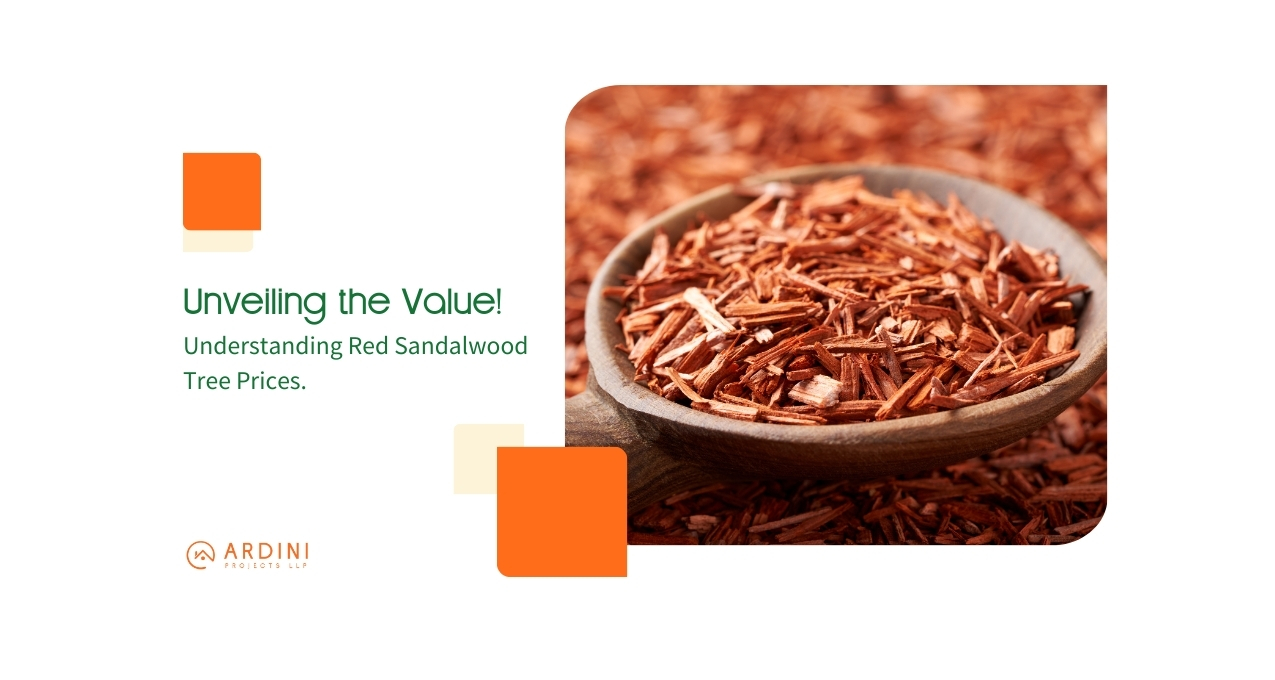Red Sandalwood Trees : Unveiling It’s Value

The allure of red sandalwood trees, also known as red chandan or lal chandan, extends far beyond its captivating reddish-brown heartwood. This precious tree boasts a rich cultural history, diverse traditional uses, and a complex market value. If you're curious about the factors determining the price of these trees, this blog will help you understand better. It delves into the world of red sandalwood farming, explores the reasons behind its value, and sheds light on the complexities of the market.
The Mystique of Red Sandalwood: Why is it Valuable?
Red sandalwood’s value stems from a confluence of factors, including:
- Limited Supply and Slow Growth: Red sandalwood trees are slow-growing, taking decades to mature and produce the prized heartwood. Unsustainable harvesting practices further limit natural resources, driving up the price.
- Unique Properties: Red sander heartwood possesses a distinctive fragrance and a fine, close grain. Its natural oils are valued for their perceived medicinal properties in various traditional practices, including Ayurveda.
- Cultural Significance: Red sandalwood holds deep cultural significance in India and other Asian countries. It’s used in religious ceremonies, artistic creations, and traditional medicine, further amplifying its value.
What Determines Red Sandalwood Tree Price?
The price of this tree isn’t a fixed number. Several factors can influence its value:
- Age and Size: Mature trees with a larger heartwood content naturally fetch a higher price.
- Wood Quality: The quality of the heartwood is crucial. Factors like color, density, and oil content significantly impact the price.
- Origin and Legality: It is sourced from sustainable plantations with ethical practices and commands a premium price compared to illegally harvested wood.
- Market Demand: Fluctuations in global demand for this red chandan, particularly in areas like essential oil production and traditional medicine, can affect prices.
Understanding the Red Sandalwood Market
The red sandalwood market is complex and can be opaque to outsiders. Here are some key considerations:
- Government Regulations: Red sandalwood is subject to strict government regulations in many countries, further influencing market dynamics.
- The Rise of Sustainable Practices: As awareness about sustainable forestry practices grows, consumers will increasingly seek ethically sourced red sanders, potentially influencing future market trends.
Beyond the Price Tag: The Importance of Sustainability
While the price of these trees is a significant factor, it shouldn’t be the sole consideration. Sustainable cultivation of these trees is paramount for the future of this precious resource. Ecowood Habitat by Ardini Farms exemplifies a commitment to responsible practices.
Ecowood Habitat: Cultivating Red Sandalwood Sustainably
Located near Bangalore, Ecowood Habitat offers a unique opportunity to learn about lal chandan cultivation and the importance of sustainability. We focus on:
- Organic Farming Methods: By utilizing organic practices, we ensure healthy soil and a thriving ecosystem for these trees.
- Sustainable Water Management: Techniques like rainwater harvesting and drip irrigation conserve precious water resources vital for their growth.
- Managed Farmland Services: Ecowood Habitat offers options for investing in red sandalwood farmland. Our expert team ensures sustainable practices are followed, safeguarding the future of this valuable tree.
Exploring the Future of Red Sandalwood
The future of these trees is intertwined with sustainability. Research into its potential applications in medicine and cosmetics holds promise, but sustainable cultivation is key. By becoming a part of Ecowood Habitat, you can contribute to a future where your red plantations remain a valuable resource for future generations.
Beyond Red Sandalwood: Exploring Sustainable Living
While this blog focused on red sanders, Ecowood Habitat offers a broader perspective on sustainable living. You can explore our offerings beyond red sanders, including:
- Organic Produce Cultivation: Learn about organic farming practices and enjoy fresh, locally sourced produce.
- Farm Stays: Immerse yourself in the beauty of working in a farm land near Bangalore.
- Educational Workshops: Deepen your knowledge about sustainable practices and eco-friendly living.
Conclusion: Invest in the Future, Choose Sustainable Red Sandalwood
Understanding the prices of these trees provides us with valuable insight into this complex market. However, the actual value lies in supporting sustainable cultivation practices for the future. By choosing ethically sourced red sanders and exploring options like those offered by Ecowood Habitat, you can contribute to a more sustainable future for this precious resource and its environment.
- Tags : #ecofriendly #ecohabitat, #redsandalwood, Invest, Managed Farming, Managed Farmland
